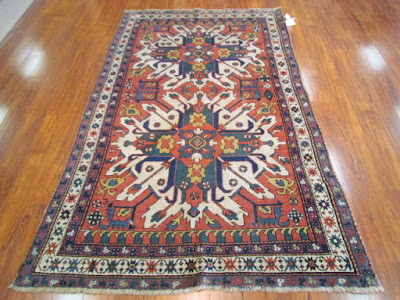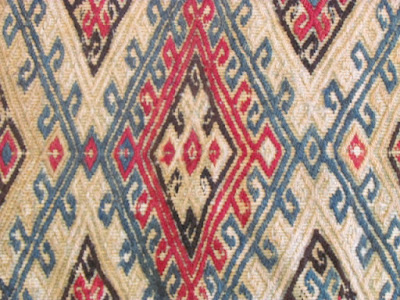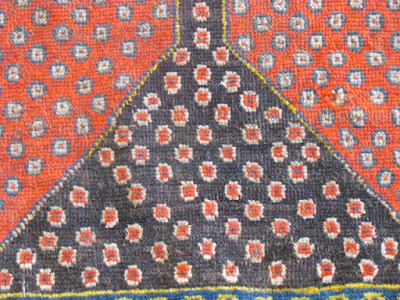Dealing in fine objects has both a good and a bad side. On the good side we get to deal in objects of interest, with long and fascinating histories. On the down side we also have to occasionally be the bearer of bad news. The story is nearly always the same. A tourist has gone to Turkey or Morocco and been fleeced. The rug is brought in for a certified appraisal. That is when the unfortunate owner realizes they have been duped. They were told the rug was silk, when in fact it was cheap and nasty mercerized cotton. They have been told the rug is a Turkish Antique, when in fact the rug is new, was made in Pakistan, was laid out in the road for cars to drive on to give them that "antique" look, then overland all the way to Istanbul.
It would be improper to mention sums of money made at the misfortune of the buyer. But it remains a simple truth that so many tourists pay many thousands more than a rug is worth. On the flip side, this simple transaction makes the rug dealer a relatively great deal of money. Once these realities are taken into consideration the buyer leaves our premise, sometimes in a state of despondency at how much money they lost, or they feel sheepish having been so obviously parted with their money, or, and this is the most common reaction, they fly into a rage, tell you that you know nothing about rugs, and that they will take their rug somewhere else. This is retail. Just bite your tongue and move along.
Possibly the most common rug where these mistakes are made is the so called "Pak-Bok", meaning, a Bokhara rug in design, but made in Pakistan. In order to understand what a "Pak-Bok" is we need to first take a cursory glance at the original Bokhara rugs.
 |
| Two Turkomen on a Turkoman Rug |
What defines a Turkoman has been the source of much consternation and confusion over the years. One thing I have repeatedly noticed is how little the history of the Turk is known. The Turks find their homeland far to the east in the Altai Mountains. Over the millennia wave after wave have been pushed west by the Chinese, with the last major thrust resulting in the Turks of Central Asia conquering much of the Middle East under their ruler Seljuk. This conquest saw the Turks move into Asia Minor about 1000 years ago. They settled there and over the centuries formed the nation known as Turkey. Thus most people today assume that Turks come from Turkey when it is the other way around.
 |
| Seljuk Armor. Impressive Stuff |
Outside of Turkey there are an additional 10 million Turkomen in Central Asia, with their population base being in Turkmenistan, formerly a Soviet of the U.S.S.R, now a sovereign nation in it's own right. But arbitrarily drawn borders that run for hundreds of miles through deserts are easy to cross. The Uzbeks, the Karakalpaks, and many other groups also belong to the Turkic speaking family. So it is no surprise that Bukhara has a large Turkoman population. It is from the name of this town, shown here on a map, that we have also inherited the name for the rug, the "Bokhara".
 |
Relation of Bokhara to Pakistan
|
To associate the name of an urban center with a non-urban, that is tribal, rug, is an inherent mistake to begin with. It is perhaps more accurate to call them Turkoman rugs and leave it at that. There are many tribal groupings in this confederacy, the largest tribes being the Tekke, Yomud, Ersari, Chowdur and Saryk. Traditionally, each tribe would use the same color palette, with reds from the madder root and deep indigo blues. The major difference would be in the use of the
gul, or tribal marking which designates which tribe the rug should be associated with. So, let us take a look at four prominant examples details.
 |
| Tekke Gul |
 |
| Saryk Gul |
 |
Yomud Gul
|
 |
| Ersari Gul |
Here is a broader picture of an Antique Tekke Turkoman showing the symmetrical placement of
guls, again in the classic color palette. When Europeans want a "Bokhara" rug, this is as close as one can get to a rug of that name.
 |
| Antique Tekke Rug |
But the tribes were always on the move over vast swathes of land, as opposed to being house-owners in Bokhara. My own theory is that Bokhara provided the original market for these rugs.
 |
| Wonderful and ancient Bukhara |
Now I could show you endless photos of Turkoman rugs but that is a subject that people write, and have written, books about for a long time. The case at hand here is the emergence of the "Pak-Bok" that has led to so many misjudged sales and gnashing of teeth.
During the 1950s and 1960s any romance associated with the ancient art of rug-making has all but disappeared. In Iran, the veritable cradle of rug weaving, the emphasis was placed on mass-production using cheap materials for a hungry Western market. A similar event occurred in Pakistan, with the emergence of the locally made "Turkoman Knock-off". Basically, the Pakistani's tapped into the market for Turkoman rugs (with which they have no meaningful connection) by mass-producing them, nearly always with the Tekke gul.
Not only this, but a new array of color was added in. Instead of the traditional red, white and blue of a genuine Turkoman now came in a myriad of colors. By far the most common look retained the Turkomen color-scheme, as is seen in this example.
Even with this very brief look at Turkoman rugs allow us to draw parallels with the famous Afghan "Elephant's Foot" rugs, which parallel Turkoman rugs in color and gul design. The Afghans clearly manipulated this Turkoman design in favor of larger guls. Many of these rugs were also made in Pakistan during the mid-20th.
However, one must remember it was the 1960s which was a very bad time for design and color. People started taking drugs and thought it might be nice to have a Tekke Turkoman in mustard-yellow, for example. Taste went straight out the window. There was no lack of color to look for, these Pakistani made "Bokhara" rugs utilized them all. Here are a few unsavory examples.
The remaining outstanding conundrum, however, is obscured to a degree by story and myth. The big rug making centers in Pakistan were Karachi and Lahore. I have heard it on good authority that these rugs were woven in the train station districts of these cities, one of which was generally referred to as "Bokhara" train station because the trains headed north to Bokhara. Whether this is true or not I can't decide. Still, a good story is a good story...



































































